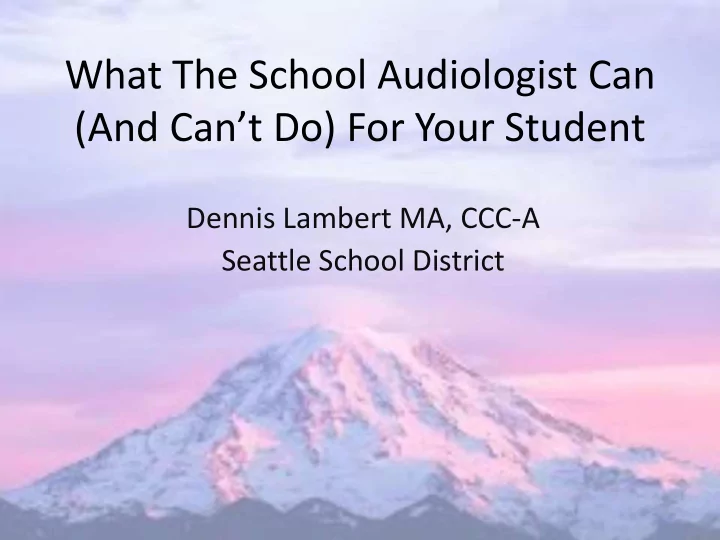

What The School Audiologist Can (And Can’t Do) For Your Student Dennis Lambert MA, CCC-A Seattle School District
Topics • The Laws • Audiology Guidelines • Section 504 • Service Plans • Individual Health Plan • Assistive Technology Guidelines
Laws Affecting Audiology Services • Individuals with Disabilities Education Act (IDEA) (633) – Part C (Birth Through 2 years) – Part B (3 through 21 years) • Section 504 Americans With Disabilities Act • No Child Left Behind 2001 • Washington Administrative Codes
NCLB and Audiology • No direct definition of the role of the audiologist • Requires students with disabilities to be included in the “educational accountability system” – with accommodations • Requires schools to make Adequate Yearly Progress • It gives audiologists some leverage with presenting the case for hearing assistance technology
Other Audiology Guidelines • Guidelines for Audiology Service Provision in and for Schools - ASHA • Serving Children With Hearing Loss in Public School Settings - ASHA
What Are Audiologists Required To Do? Sub Section 300.113 “Each public agency must ensure that hearing aids worn in school by children with hearing impairments, including deafness, are functioning properly”
Cochlear Implants - IDEA • “Each public agency must ensure that the external components of surgically implanted medical devices are functioning properly” • “A public agency is not responsible for the post-surgical maintenance, programming, or replacement of the medical device or any external component”
Audiology Services • Identification • Referrals • (Re)Habilitation • Prevention • Counseling • Hearing Assistance Technology
IEP vs Service Plan vs 504 vs IHP • What’s the difference? • Which one is better for my child? • Which one offers the most services?
Service Plans • Parent(s) decline Direct Service (Goals/Objectives) • Student is eligible for Technology (equipment)
Individual Health Plan (IHP) • Initiated by the school nurse • Does not require parent involvement • Accommodations Has the same legal standing as a 504 plan
Section 504 of ADA • General Education Students • Accommodations – Not direct service i.e. therapy • Unfunded mandate
504 Process • Believe a disability exists • Substantially limits a life function – Learning – Hearing – Speaking – Walking – Breathing – Caring for Self – Working
504 Plan - Legal Document • School’s responsibilities – Provide technology – Other accommodations • Student’s responsibilities • Parent’s responsibilities – Provide updated audiogram – Inform school of changes
Assistive Technology (300.5) “Item, piece of equipment, or product system… used to increase, maintain, or Improve functioning capabilities”
Assistive Technology Services • Evaluation of need • Purchase, lease technology • Select, fit, adapt, repair • Train staff, teacher, parents • Train professionals, employer
Hearing Assistance Technology Assessing need for HAT • Each district develops their own guidelines – Determine candidacy – Specific recommendation – Purchase and fit HAT – Verify – Validate
What Does Seattle Schools do? • Eligibility Criteria – Bilateral hearing loss – Unilateral hearing loss – Fluctuating hearing loss – Auditory processing disorder • Hearing aid wears are strong candidates
Documentation of Need • Stated in IEP, SP, or 504 plan • 30 day trial with pre-post questionnaires • Audiologist’s recommendation
Monitoring Outcomes – System is being used – Teacher Questionnaire • Is student attending better • Asks less questions • Less frequently off task • Says “huh/what?” less often • Improved academic • Improved social/emotional • Student Questionnaire • Can you hear the teacher better?
HAT Training and Monitoring • Orientation with teacher, student, and parent • Observation – classroom • Visit the next day • Classroom presentation • Documentation – Questionnaires
Recommend
More recommend